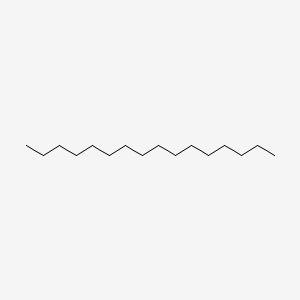| MeSH term | MeSH ID | Detail |
|---|---|---|
| Lupus Erythematosus, Systemic | D008180 | 43 associated lipids |
| Body Weight | D001835 | 333 associated lipids |
| Coronary Disease | D003327 | 70 associated lipids |
| Peritonitis | D010538 | 38 associated lipids |
| Hyperplasia | D006965 | 34 associated lipids |
| Glomerulonephritis | D005921 | 35 associated lipids |
| Encephalomyelitis, Autoimmune, Experimental | D004681 | 26 associated lipids |
| Keratosis | D007642 | 9 associated lipids |
| Serratia Infections | D016868 | 2 associated lipids |
Hexadecane
Hexadecane is a lipid of Fatty Acyls (FA) class. The involved functions are known as Analyte. The related lipids are Fatty Acids and palmitoleic acid.
Cross Reference
Introduction
To understand associated biological information of Hexadecane, we collected biological information of abnormalities, associated pathways, cellular/molecular locations, biological functions, related genes/proteins, lipids and common seen animal/experimental models with organized paragraphs from literatures.
What diseases are associated with Hexadecane?
There are no associated biomedical information in the current reference collection.
Possible diseases from mapped MeSH terms on references
We collected disease MeSH terms mapped to the references associated with Hexadecane
PubChem Associated disorders and diseases
What pathways are associated with Hexadecane
There are no associated biomedical information in the current reference collection.
PubChem Biomolecular Interactions and Pathways
Link to PubChem Biomolecular Interactions and PathwaysWhat cellular locations are associated with Hexadecane?
There are no associated biomedical information in the current reference collection.
What functions are associated with Hexadecane?
Related references are published most in these journals:
| Function | Cross reference | Weighted score | Related literatures |
|---|
What lipids are associated with Hexadecane?
Related references are published most in these journals:
| Lipid concept | Cross reference | Weighted score | Related literatures |
|---|
What genes are associated with Hexadecane?
There are no associated biomedical information in the current reference collection.
What common seen animal models are associated with Hexadecane?
There are no associated biomedical information in the current reference collection.
NCBI Entrez Crosslinks
All references with Hexadecane
Download all related citations| Authors | Title | Published | Journal | PubMed Link |
|---|---|---|---|---|
| Yakimov MM et al. | Characterization of antarctic hydrocarbon-degrading bacteria capable of producing bioemulsifiers. | 1999 | New Microbiol. | pmid:10423744 |
| Taniguchi A | [Cell kinetic effects of crude coal tar application plus long wave ultraviolet radiation on normal and hyperproliferative epidermis of guinea pig skin]. | 1991 | Nihon Hifuka Gakkai Zasshi | pmid:1942590 |
| Meunier J et al. | [Recurrent paroxysmal myoglobinuria with acute renal insufficiency caused by muscular carnitine (palmitoyltransferase deficiency. A case]. | 1982 | Nouv Presse Med | pmid:7145668 |
| Stamatova I et al. | In vitro evaluation of yoghurt starter lactobacilli and Lactobacillus rhamnosus GG adhesion to saliva-coated surfaces. | 2009 | Oral Microbiol. Immunol. | pmid:19416451 |
| Ellen RP et al. | Kinetics of lactose-reversible coadhesion of Actinomyces naeslundii WVU 398A and Streptococcus oralis 34 on the surface of hexadecane droplets. | 1994 | Oral Microbiol. Immunol. | pmid:7870472 |
| Leevy WM et al. | Correlation of bilayer membrane cation transport and biological activity in alkyl-substituted lariat ethers. | 2005 | Org. Biomol. Chem. | pmid:15858645 |
| Einsele A and Fiechter A | Growth behavior of Candida tropicalis in batch fermentation processes on n-hexadecane as substrate. | 1972 | Pathol Microbiol (Basel) | pmid:5019324 |
| Koziara JM et al. | Blood compatibility of cetyl alcohol/polysorbate-based nanoparticles. | 2005 | Pharm. Res. | pmid:16132346 |
| Brigger I et al. | Near infrared with principal component analysis as a novel analytical approach for nanoparticle technology. | 2000 | Pharm. Res. | pmid:11087046 |
| Yazdanian M et al. | Correlating partitioning and caco-2 cell permeability of structurally diverse small molecular weight compounds. | 1998 | Pharm. Res. | pmid:9755906 |
